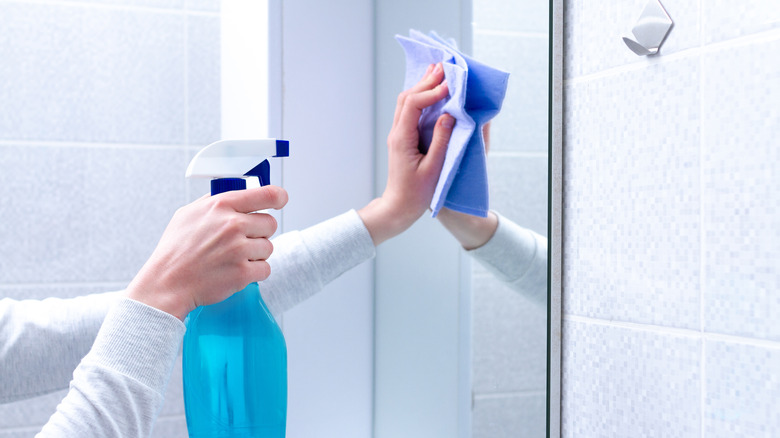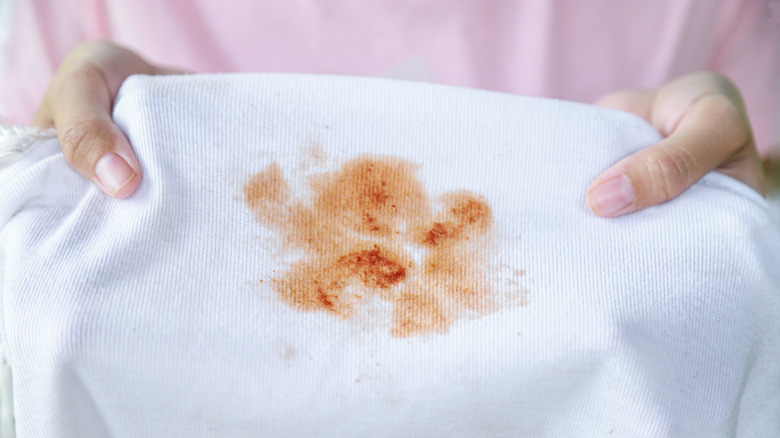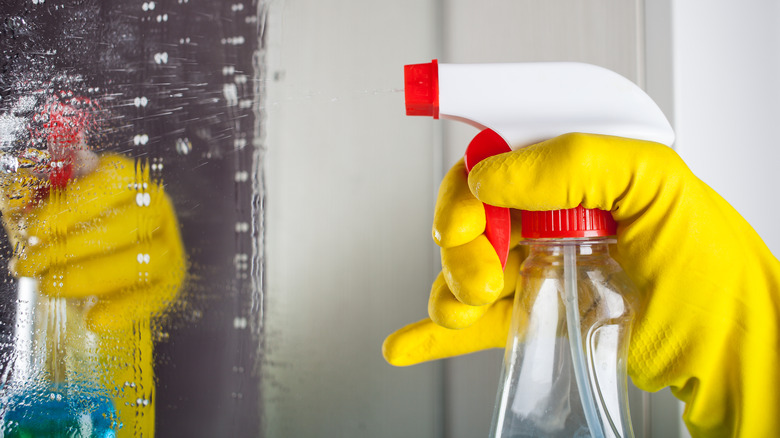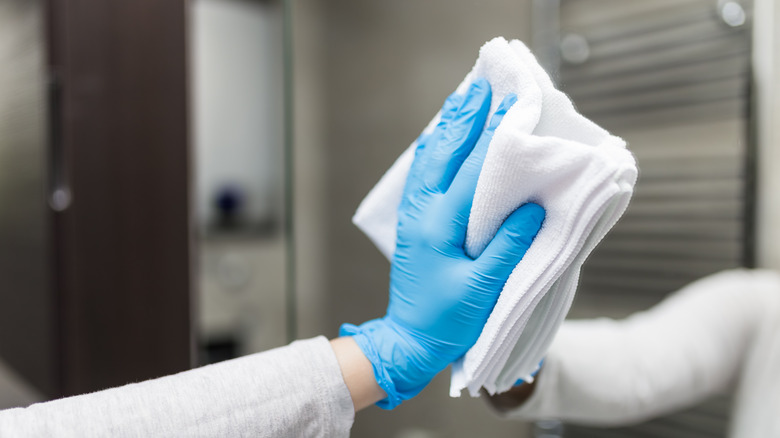3 Mistakes People Make When Cleaning Their Mirrors
It's pretty easy to tell when it's time to give those mirrors a good cleaning. Smudges start forming, splatters slowly work their way across the surface, and your reflection isn't as clear as it used to be. Although you might think that running a towel over the dewy exterior as soon as you step out of a hot shower is enough to keep your mirrors clean, think again. Just like other areas of your bathroom — and your home in general — it's important to keep them pristine. According to Time, the bathroom can be a breeding ground for germs and bacteria. Germs may start in or around the toilet, then spread to most surfaces. This includes countertops, toothbrushes, and mirrors.
Adding a proper mirror cleaning to your regular routine will not only keep it from collecting grimy fingerprints and smudges, but also maintain its integrity. If your mirrors are framed by wood, metal, or plastic you want to ensure that splatters and gunk don't ruin the finish or seep into the nooks and crannies. It'll take a little more effort to make those surfaces shiny, but that doesn't mean you have to spend all day scrubbing and buffing. By simply avoiding the following common mistakes most people make when they clean their mirrors, you can wind up with great results.
Using dirty or improper cloths
It can be frustrating when you've finally worked up the gumption to give all of your mirrors their due attention, only to leave them more streaky than when you started. This can be solved by using a proper and clean cloth. This may seem like a no-brainer, but if you're attempting to wipe a surface with a towel or rag that has a little bit of grease or dirt on it, chances are you won't get an immaculate finish. So ditch those old rags and opt for a better solution.
Your new best friend when it comes to cleaning glass, windows, your flat screen TV, and especially mirrors, is a microfiber cloth. They're made of a synthetic and durable material that is easy to clean and lasts longer than most cotton cloths, according to Western States PEHSU. Microfiber cloths are soft to the touch and gentle to use on mirrors and screens, so you can be sure they won't scratch or damage the surface. Unlike paper towels which can leave annoying little fuzzy bits behind after wiping, microfiber material is positively charged, which actively attracts dust and dirt to it.
As an extra bonus, these cloths are inexpensive and can be found at most grocery, department, and even discount dollar stores. Microfiber cloths can be tossed into your regular laundry when they need to be washed. They also dry quickly, meaning bacteria and germs don't have time to form.
Too reliant on glass cleaners
Glass cleaner may seem like the perfect solution to cleanse your streaky mirrors, however, it might not give you the best results and may actually be irritating to your eyes, nose, and skin. Some of these specialized cleaners contain ingredients like ethanol, methanol, isopropyl alcohol, and even ammonia that could cause health issues if inhaled or accidentally ingested, according to Mount Sinai. If you do choose to use these types of products, you should make sure you're in a well-ventilated room. It is not recommended that you use them on your car's rearview mirror as the smell can be trapped within your vehicle.
For a more natural solution that is sure to remove the gunk from your mirrors and provide you with a grime-free reflection, try this affordable eco-friendly alternative. In a spritz bottle mix equal parts water to distilled white vinegar and use that to spray on your mirror. Allow it to sit for a few seconds, then wipe away with a reusable microfiber cloth, as per The David Suzuki Foundation.
On its own, vinegar is a versatile cleaning tool. Its acetic acid properties allow it to cut through tough grease and remove pesky stains. Using it is an environmentally friendly way to take care of your mirrors without resorting to expensive chemical-filled products. For soap scum or water spots, add a tablespoon of cornstarch to the mixture. This will help lift the tough-to-tackle stains.
Wrong technique
Now that you have a fresh microfiber cloth and the perfect eco-friendly cleaning solution, you might think it's time to get cracking on all of those dirty mirrors. But hang on for one more second, because the manner in which you wipe them down could actually be affecting the outcome. Whether you like the small swirling motion of tiny circles or would rather jump in and haphazardly swish that cloth back and forth and up and down with no regard for consistency, you might need to stop and take notes. These two methods could very well be the reason that your mirrors aren't coming out as sparkling as you want.
Author and cleaning expert Melissa Maker, who runs the popular YouTube channel Clean My Space, explained via the Rachel Ray Show that the circular method of cleaning mirrors is a definite no-no. When you work the cloth in circles over and over again, you move over a dirty area multiple times, thus eliminating the effectiveness of using a clean cloth with helpful cleaners. Instead, Maker suggests that after spraying your solution on the mirror, you should take your microfiber cloth and wipe in an "S" motion starting at the top. As you snake your way down to the bottom, you'll hit the whole mirror without overlapping on dirty areas, which could gunk up your cloth. Now sit back and reflect on a spot-free shine.



